Investigation on the Association of Differential Evolution and Constructal Design for Geometric Optimization of Double Y-Shaped Cooling Cavities Inserted into Walls with Heat Generation
Abstract
:Featured Application
Abstract
1. Introduction
2. Mathematical and Numerical Modeling
2.1. Description of the Cavity Inserted in the Solid Domain Problem
- 1
- The problem is considered at the steady-state;
- 2
- The heat generation per unit volume (q‴) is constant in the solid domain;
- 3
- The thermal conductivity is also constant;
- 4
- The domain is two-dimensional.
2.2. Numerical Solution of Heat Transfer in Solid Domain
2.3. Application of Constructal Design to Design of Double Y-Shaped Cavity
3. Optimization Methodology
3.1. Differential Evolution Algorithm
- Generate a first population with NP vectors xi,G, and i = 1, 2, 3, ..., NP, being G the current generation.
- Apply the mutation operator for each vector in the population as given by:where the indexes r1, r2, r3 ∈ 1, 2, 3, ..., NP are integers randomly generated and mutually different. The F controls the amplification of the differential term .
- Create ui,G+1 = (u1i,G+1, u2i,G+1, ..., uDi,G+1) which is a trial vector, being D the length of the vector (dimension of the problem). The trial vector is a combination between xi,G and vi,G+1 determined by:where rnd() is a function that generates a random number between 0 and 1, and CR is the crossover probability. The jr ∈ [1...D] is randomly generated and assurances that vji,G differs from xji,G by inserting at least one of the vi,G elements.
- Select the best solution for the next generation G+1 comparing xi,G with ui,G+1 by a Greedy criterion:
3.2. Experiments and Statistical Analysis
4. Results and Discussion
4.1. Optimization Results for One Degree of Freedom
4.2. Optimization Results for Two Degrees of Freedom
4.3. Optimization Results for Three Degrees of Freedom
4.4. Optimization Results for Four Degrees of Freedom
5. Conclusions
Author Contributions
Funding
Data Availability Statement
Acknowledgments
Conflicts of Interest
Nomenclature
| A | Area, m2 |
| CR | Crossover rate of differential evolution algorithm |
| F | Amplification factor of mutation function of the differential evolution algorithm |
| G | Current generation of the differential evolution algorithm |
| H | Height of the solid with internal heat generation, m |
| H0 | Height of the cavity stem, m |
| H1 | Thickness of the superior bifurcated branches of the cavity, m |
| H2 | Thickness of the inferior bifurcated branches of the cavity, m |
| k | Thermal conductivity of the solid with heat generation, W m−1 K−1 |
| L | Length of the solid wall with internal heat generation, m |
| L0 | Thickness of the cavity stem, m |
| L1 | Length of the superior bifurcated branches of the cavity, m |
| L2 | Length of the inferior bifurcated branches of the cavity, m |
| NP | Total number of solutions (population size) in the differential evolution algorithm |
| NG | Total number of generations (total iterations of the differential evolution algorithm) |
| OF | Objective function, solver of the heat diffusion equation |
| q | Heat transfer rate, W |
| T | Temperature, K |
| Solution of the next generation of differential evolution algorithm | |
| W | Width, m |
| Trial vector, i.e., candidate solution of differential evolution algorithm | |
| x, y | Cartesian coordinates, m |
| Greek symbol | |
| ΔE | Difference between objective function cost for the new and best solution. |
| θ | Dimensionless temperature |
| φ | Fraction area of the cavity |
| α | Angle of inferior branch of the cavity |
| β | Angle of superior branch of the cavity |
| Superscripts | |
| (˜) | Dimensionless variables. |
| Subscripts | |
| c | Cavity |
| min | Minimum |
| max | Maximum |
| m | Once minimized |
| nm | n times minimized |
| no | n times optimized |
| r | Random index for operations with population solutions in mutation function |
| 0, 1, 2 | Variable indexes of height and length for stem, inferior and superior branches |
References
- Bejan, A. Constructal-theory network of conducting paths for cooling a heat generating volume. Int. J. Heat Mass Transf. 1997, 40, 799–816. [Google Scholar] [CrossRef]
- Bejan, A. Freedom and Evolution: Hierarchy in Nature, Society and Science; Springer International Publishing: Cham, Switzerland, 2020; ISBN 978-3-030-34008-7. [Google Scholar]
- Bejan, A. Shape and Structure, from Engineering to Nature; Cambridge University Press: Cambridge, UK, 2000. [Google Scholar]
- Dos Santos, E.D.; Isoldi, L.A.; Gomes, M.D.N.; Rocha, L.A.O. The Constructal Design Applied to Renewable Energy Systems. In Sustainable Energy Technologies; Rincón-Mejía, E., de las Heras, A., Eds.; CRC Press: Boca Raton, FL, USA, 2017; pp. 45–62. ISBN 978-1-315-26997-9. [Google Scholar]
- Rocha, L.A.O.; Lorente, S.; Bejan, A. Constructal Theory in Heat Transfer. In Handbook of Thermal Science and Engineering, 1st ed.; Springer International Publishing: Cham, Switzerland, 2017; pp. 1–32. [Google Scholar] [CrossRef]
- Gonzales, G.V.; Lorenzini, G.; Isoldi, L.A.; Rocha, L.A.O.; Dos Santos, E.D.; Neto, A.S. Constructal Design and Simulated Annealing applied to the geometric optimization of an isothermal Double T-shaped cavity. Int. J. Heat Mass Transf. 2021, 174, 121268. [Google Scholar] [CrossRef]
- Biserni, C.; Rocha, L.A.O.; Bejan, A. Inverted fins: Geometric optimization of the intrusion into a conducting wall. Int. J. Heat Mass Transf. 2004, 47, 2577–2586. [Google Scholar] [CrossRef]
- Biserni, C.; Rocha, L.A.O.; Stanescu, G.; Lorenzini, E. Constructal H-shaped cavities according to Bejan’s theory. Int. J. Heat Mass Transf. 2007, 50, 2132–2138. [Google Scholar] [CrossRef]
- Xie, Z.; Chen, L.; Sun, F. Geometry optimization of T-shaped cavities according to constructal theory. Math. Comput. Model. 2010, 52, 1538–1546. [Google Scholar] [CrossRef]
- Lorenzini, G.; Biserni, C.; Isoldi, L.A.; dos Santos, E.D.; Rocha, L.A.O. Constructal Design applied to the geometric optimization of Y-shaped cavities embedded in a conducting medium. ASME-J. Electron. Packag. 2011, 133, 041008. [Google Scholar] [CrossRef]
- Lorenzini, G.; Biserni, C.; Rocha, L.A.O. Geometric optimization of X-shaped cavities and pathways according to Bejan’s theory: Comparative analysis. Int. J. Heat Mass Transf. 2014, 73, 1–8. [Google Scholar] [CrossRef]
- Hajmohammadi, M.R. Introducing a ψ-shaped cavity for cooling a heat generating medium. Int. J. Therm. Sci. 2017, 121, 204–212. [Google Scholar] [CrossRef]
- Hajmohammadi, M.R. Optimal design of tree-shaped inverted fins. Int. J. Heat Mass Transf. 2018, 116, 1352–1360. [Google Scholar] [CrossRef]
- Lorenzini, G.; Biserni, C.; da Silva Diaz Estrada, E.; Domingues Dos Santos, E.; André Isoldi, L.; Oliveira Rocha, L.A. Genetic Algorithm Applied to Geometric Optimization of Isothermal Y-Shaped Cavities. J. Electron. Packag. 2014, 136, 031011. [Google Scholar] [CrossRef]
- Lorenzini, G.; Biserni, C.; Estrada, E.D.; Isoldi, L.A.; Dos Santos, E.D.; Rocha, L.A.O. Constructal Design of Convective Y-Shaped Cavities by Means of Genetic Algorithm. J. Heat Transf. 2014, 136, 071702. [Google Scholar] [CrossRef]
- Gonzales, G.V.; da SDEstrada, E.; Emmendorfer, L.R.; Isoldi, L.A.; Xie, G.; Rocha LA, O.; Dos Santos, E.D. A comparison of simulated annealing schedules for constructal design of complex cavities intruded into conductive walls with internal heat generation. Energy 2015, 93, 372–382. [Google Scholar] [CrossRef]
- Gonzales, G.V.; Dos Santos, E.D.; Isoldi, L.A.; Rocha, L.A.O.; Silva Neto, A.J.; Telles, W.R. Constructal Design of Double T-shaped cavity with stochastic methods Luus-Jaakola and Simulated Annealing. Defect Diffus. Forum 2017, 370, 152–161. [Google Scholar] [CrossRef]
- Gonzales, G.V.; Isoldi, L.A.; Rocha, L.A.O.; Silva Neto, A.J.; Dos Santos, E.D. Evaluation of a differential evolution/constructal design algorithm for geometrical optimization of double T-shaped cavity intruded into a heat generating wall. Defect Diffus. Forum 2019, 396, 145–154. [Google Scholar] [CrossRef]
- Fagundes, T.M.; Lorenzini, G.; Estrada, E.D.S.; Isoldi, L.A.; Dos Santos, E.D.; Rocha, L.A.O.; da Silva Neto, A.J. Constructal Design of Conductive Asymmetric Tri-Forked Pathways. J. Eng. Thermophys. 2019, 28, 26–42. [Google Scholar] [CrossRef]
- Echevarría, L.C.; Santiago, O.L.; Fajardo, J.A.H.; Silva Neto, A.J.; Sánchez, D.J. A variant of the particle swarm optimization for the improvement of fault diagnosis in industrial systems via faults estimation. Eng. Appl. Artif. Intell. 2012, 28, 36–51. [Google Scholar] [CrossRef]
- Platt, G.M.; Lima, L.V.P.D.C. Azeotropy in a refrigerant system: A useful scenario to test and compare metaheuristics. Int. J. Metaheuristics 2018, 7, 43. [Google Scholar] [CrossRef]
- De-La-Cruz-Martinez, S.J.; Mezura-Montes, E. Boundary Constraint-Handling Methods in Differential Evolution for Mechanical Design Optimization. In Proceedings of the 2020 IEEE Congress on Evolutionary Computation, CEC 2020, Glasgow, UK, 19–24 July 2020. [Google Scholar]
- Özisik, M.N. Heat Conduction, 2nd ed.; John Wiley and Sons Inc.: Raleigh, NC, USA, 1993. [Google Scholar]
- Reddy, J.N.; Gartling, D.K. The Finite Element Method in Heat Transfer and Fluid Dynamics; McGrawHill: New York, NY, USA, 1994. [Google Scholar]
- MATLAB. Partial Differential Equation Toolbox User’s Guide R2018b; The MathWorks, Inc.: Natick, MA, USA, 2018. [Google Scholar]
- Storn, R.; Price, K. Differential Evolution—A Simple and Efficient Heuristic for Global Optimization over Continuous Spaces. J. Glob. Optim. 1997, 11, 341–359. [Google Scholar] [CrossRef]
- R Core TEAM. R: A language and environment for statistical computing. In R Foundation for Statistical Computing; R Core Team: Vienna, Austria, 2021. [Google Scholar]
- Shapiro, A.S.S.; Wilk, M.B. An Analysis of Variance Test for Normality (Complete Samples). Biom. Trust 1965, 52, 591–611. [Google Scholar] [CrossRef]
- Kruskal, W.H.; Wallis, W.A. Use of ranks in one-criterion variance analysis stable. J. Am. Stat. Assoc. 1952, 47, 583–621. [Google Scholar] [CrossRef]
- Dunn, O.J. Multiple Comparisons Using Rank Sums. Technometrics 1964, 6, 241–252. [Google Scholar] [CrossRef]
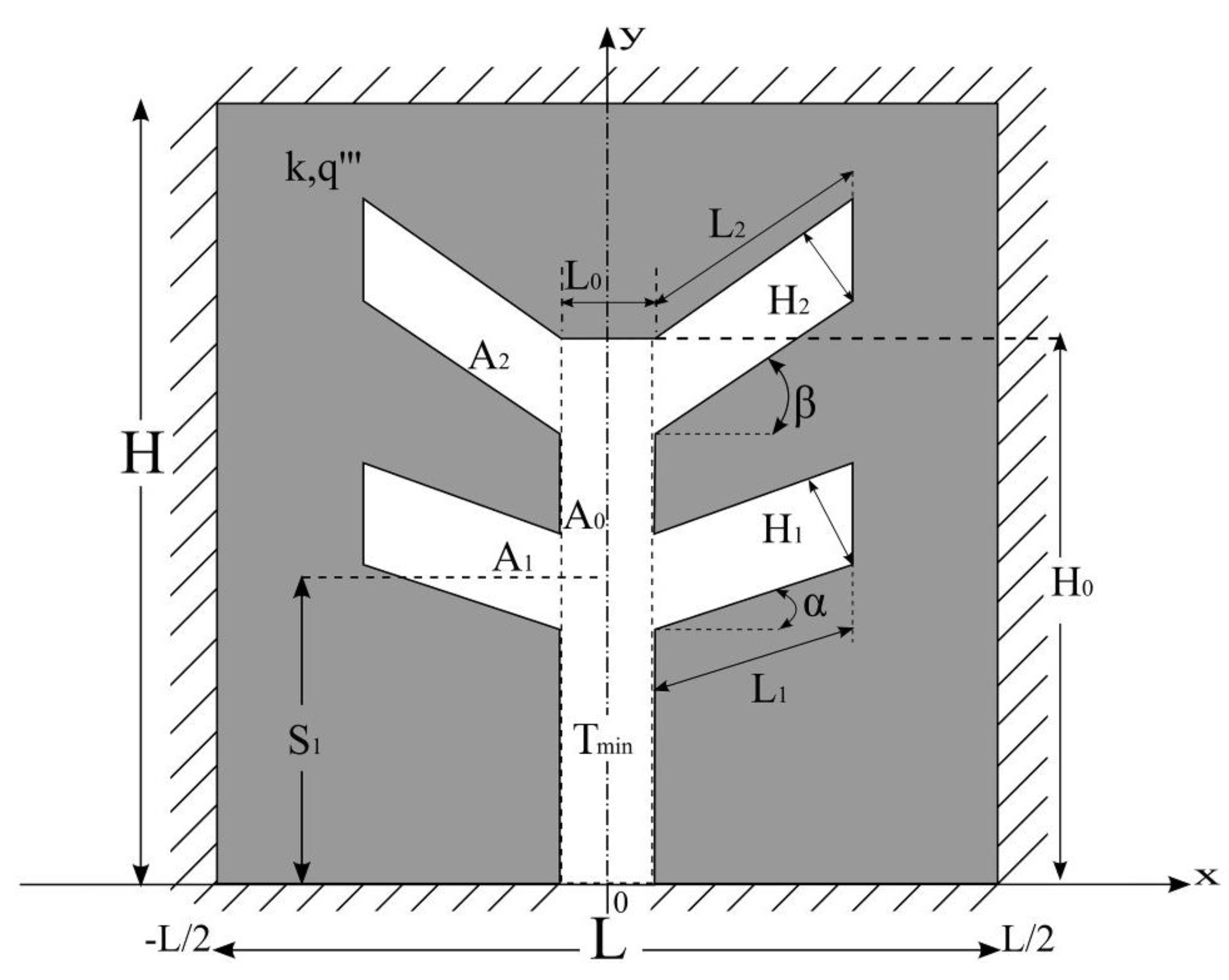
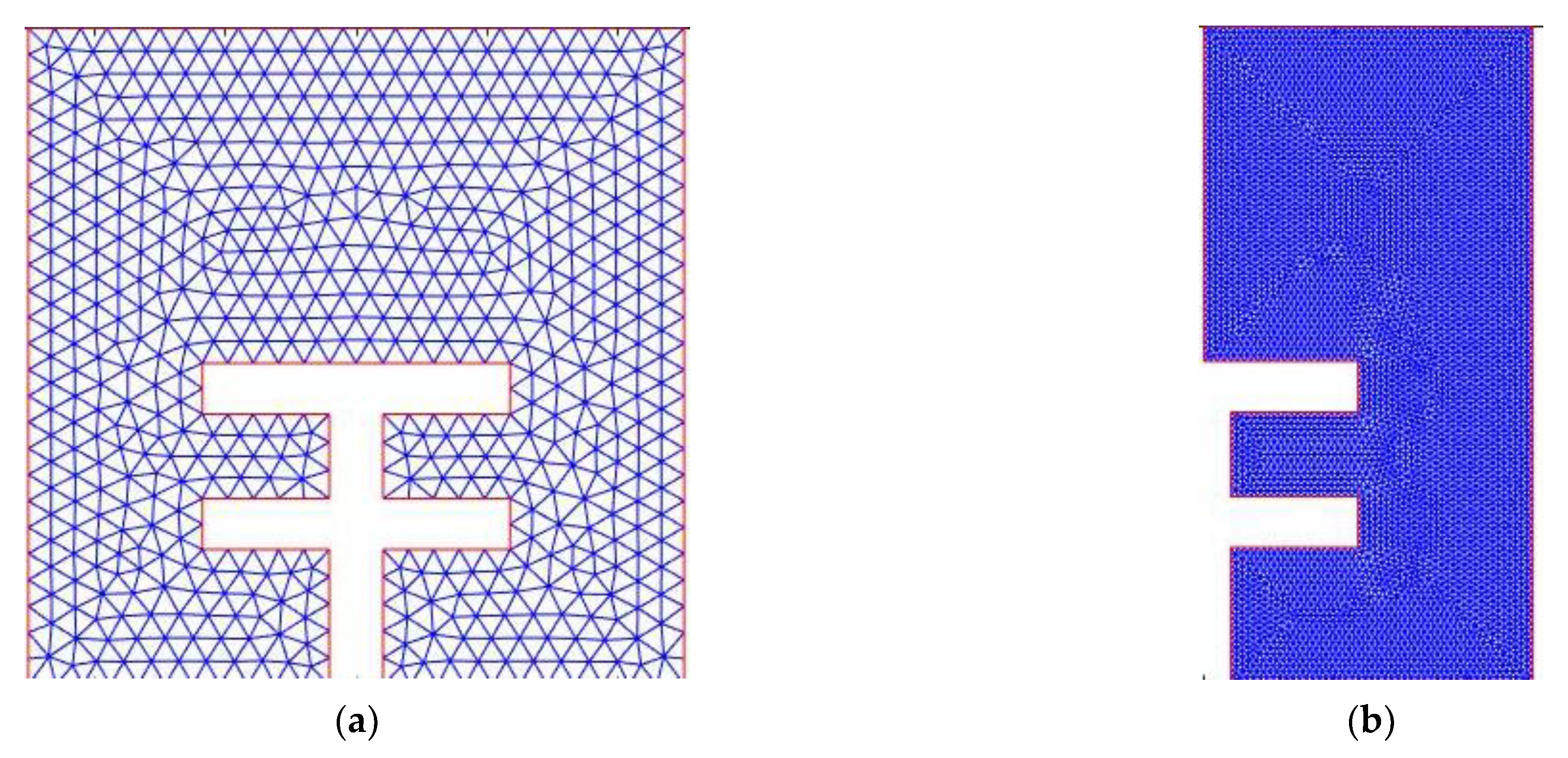
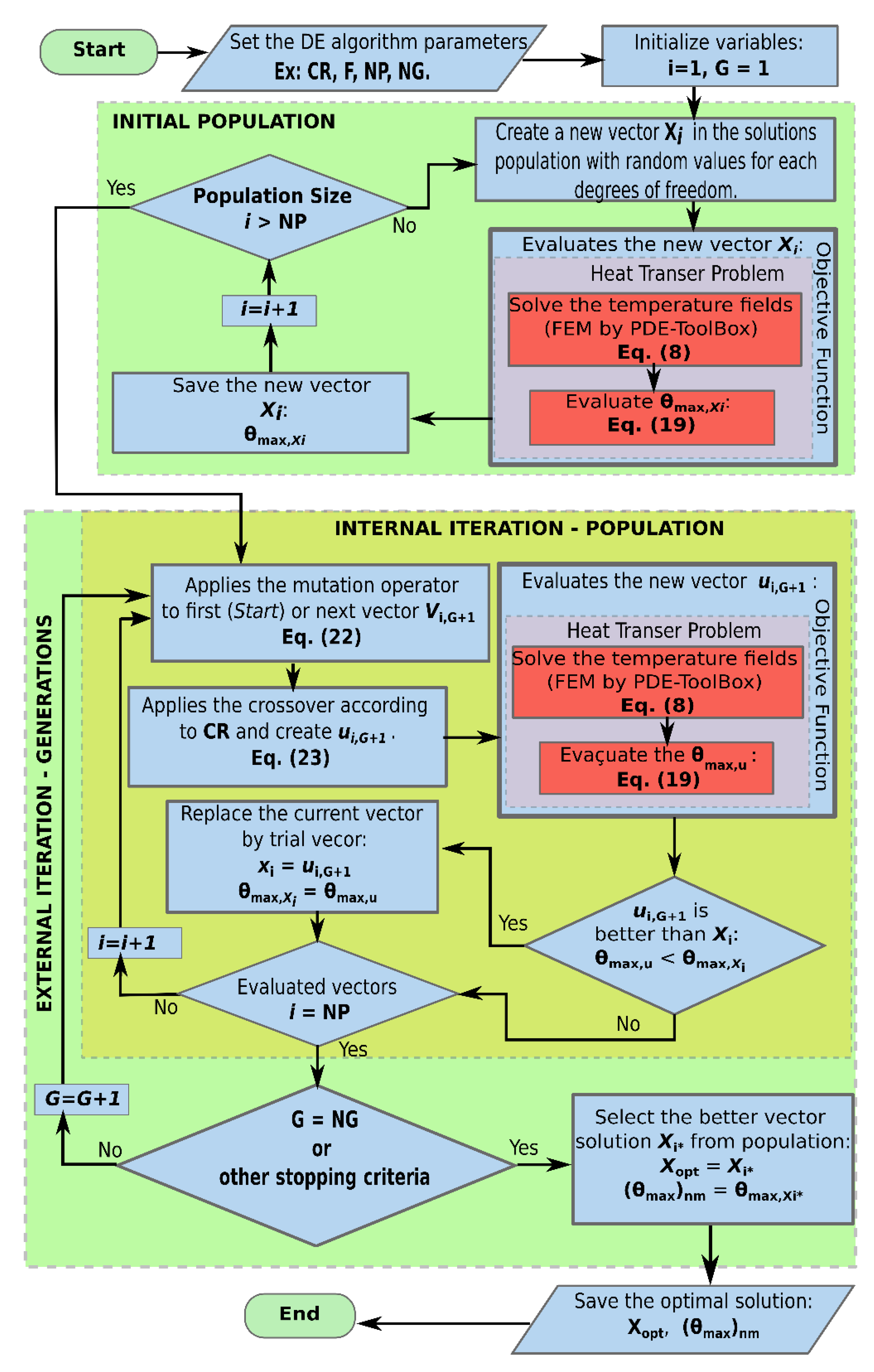
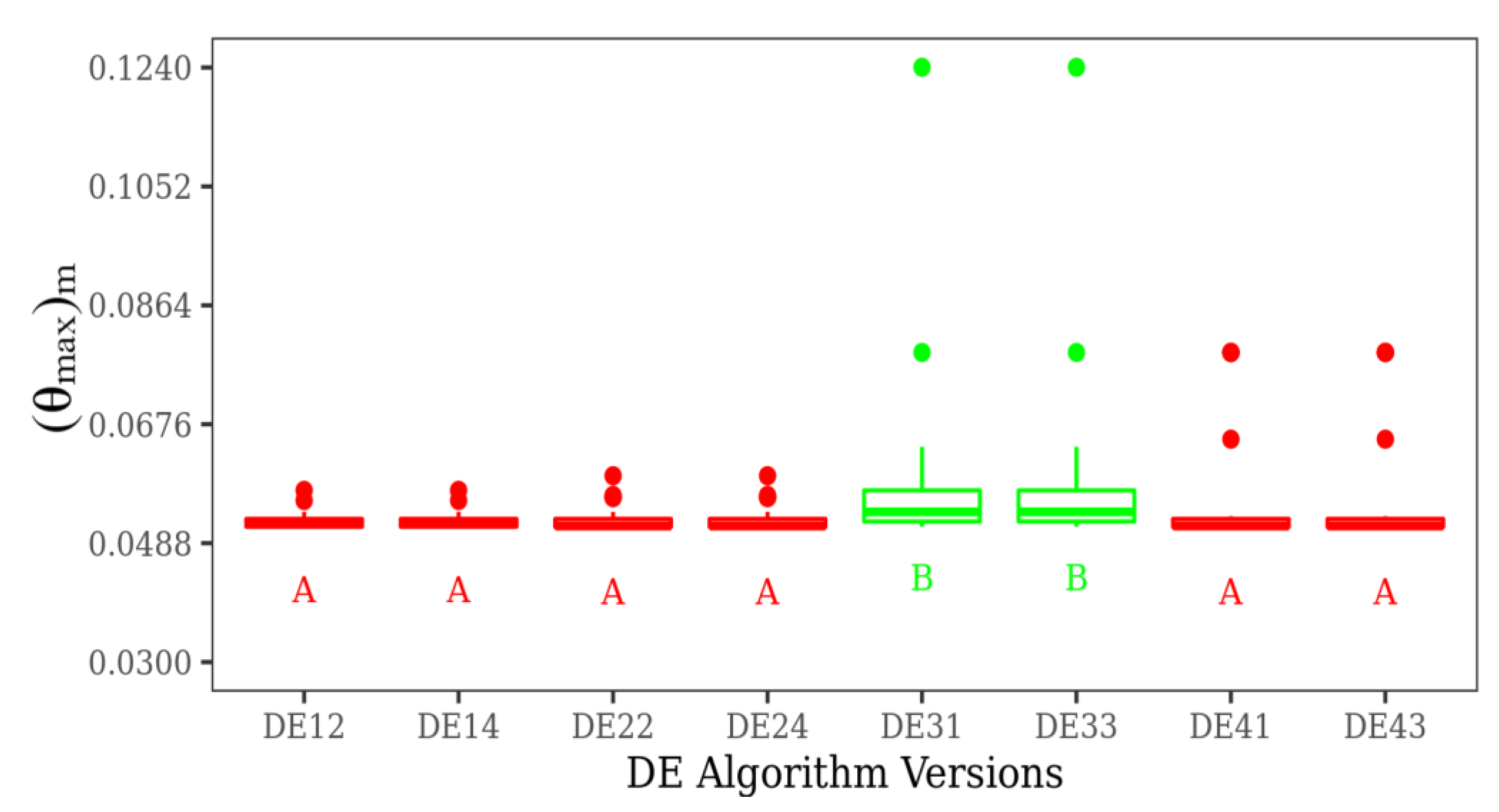
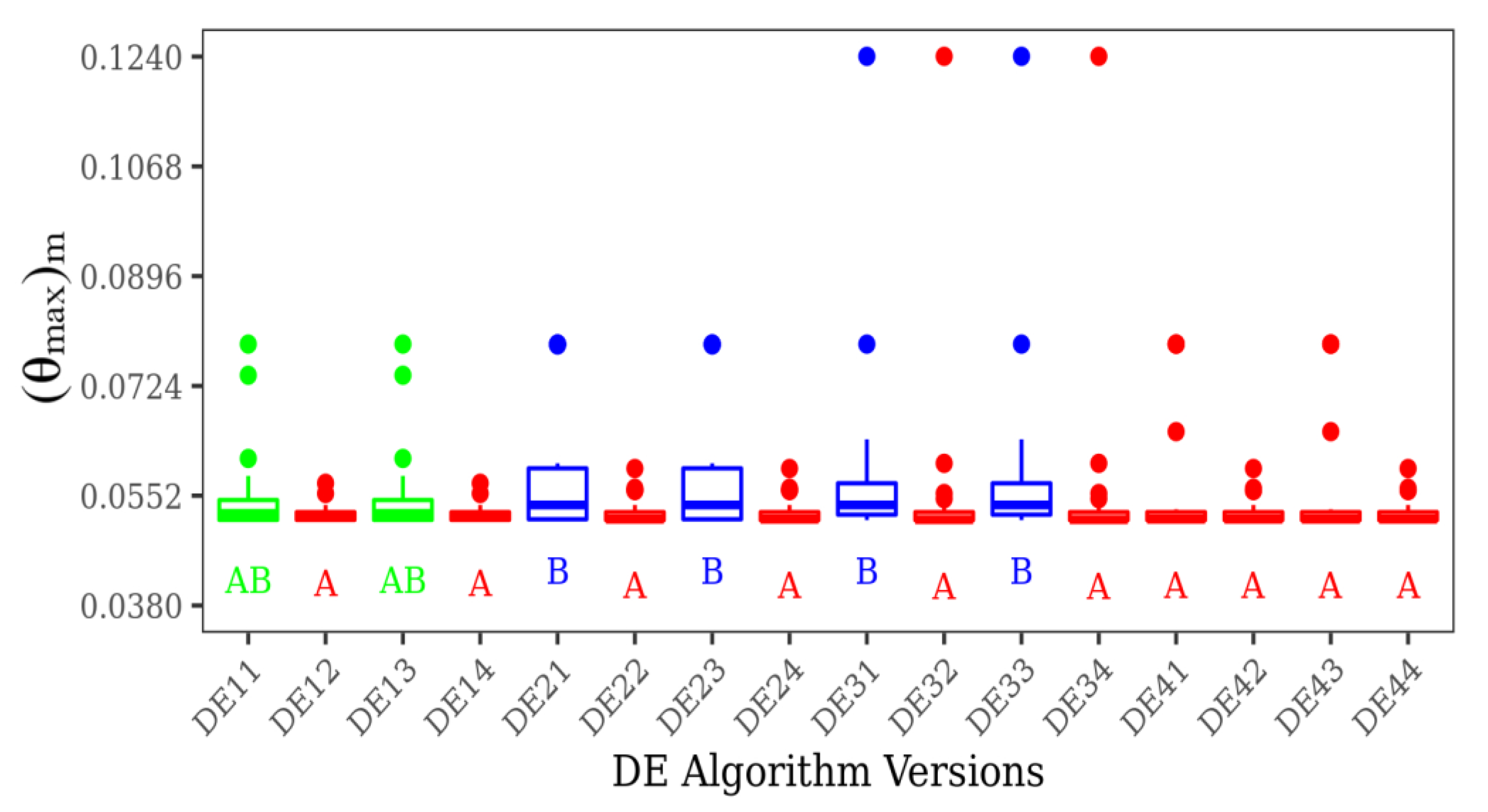
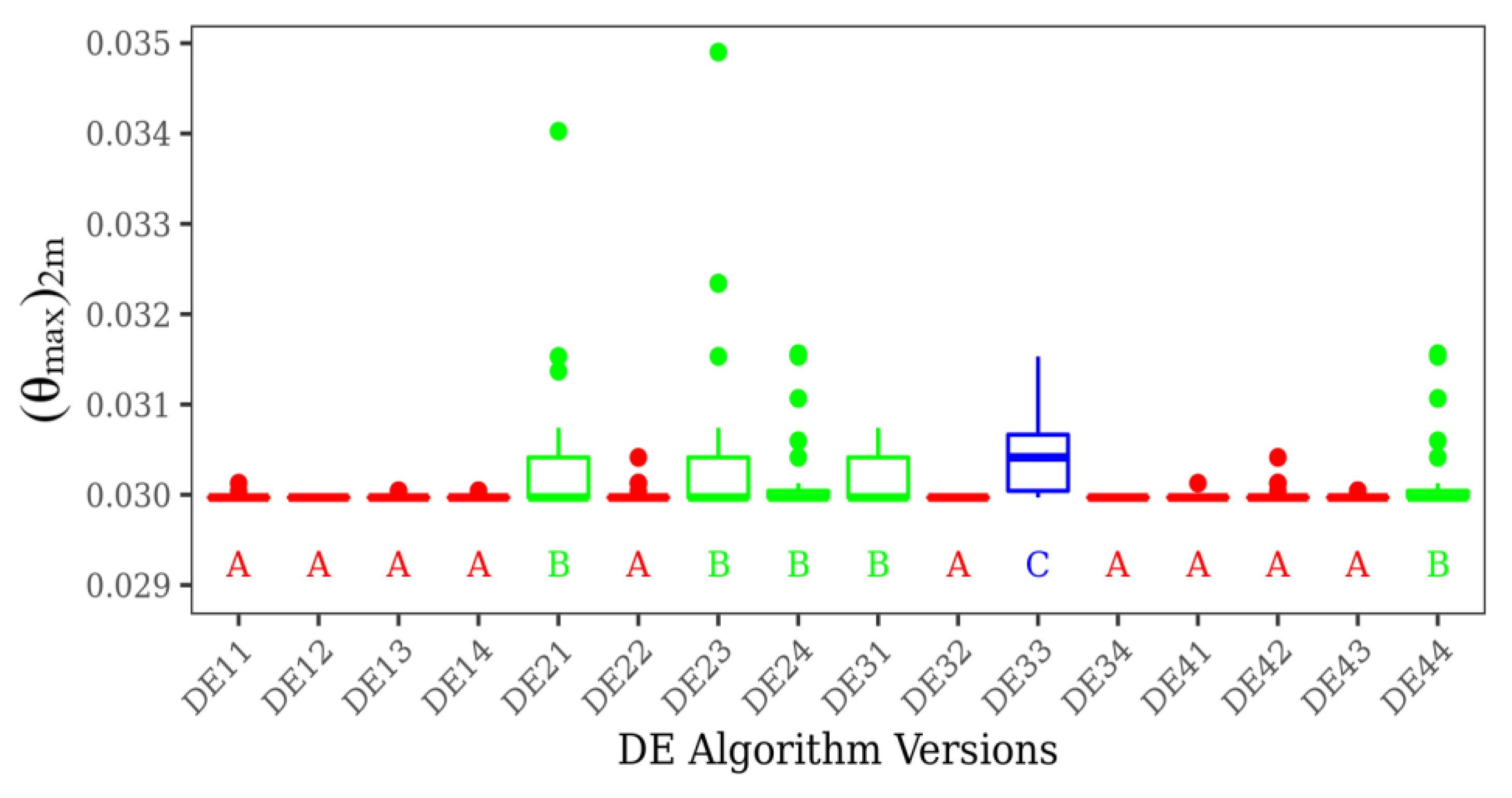
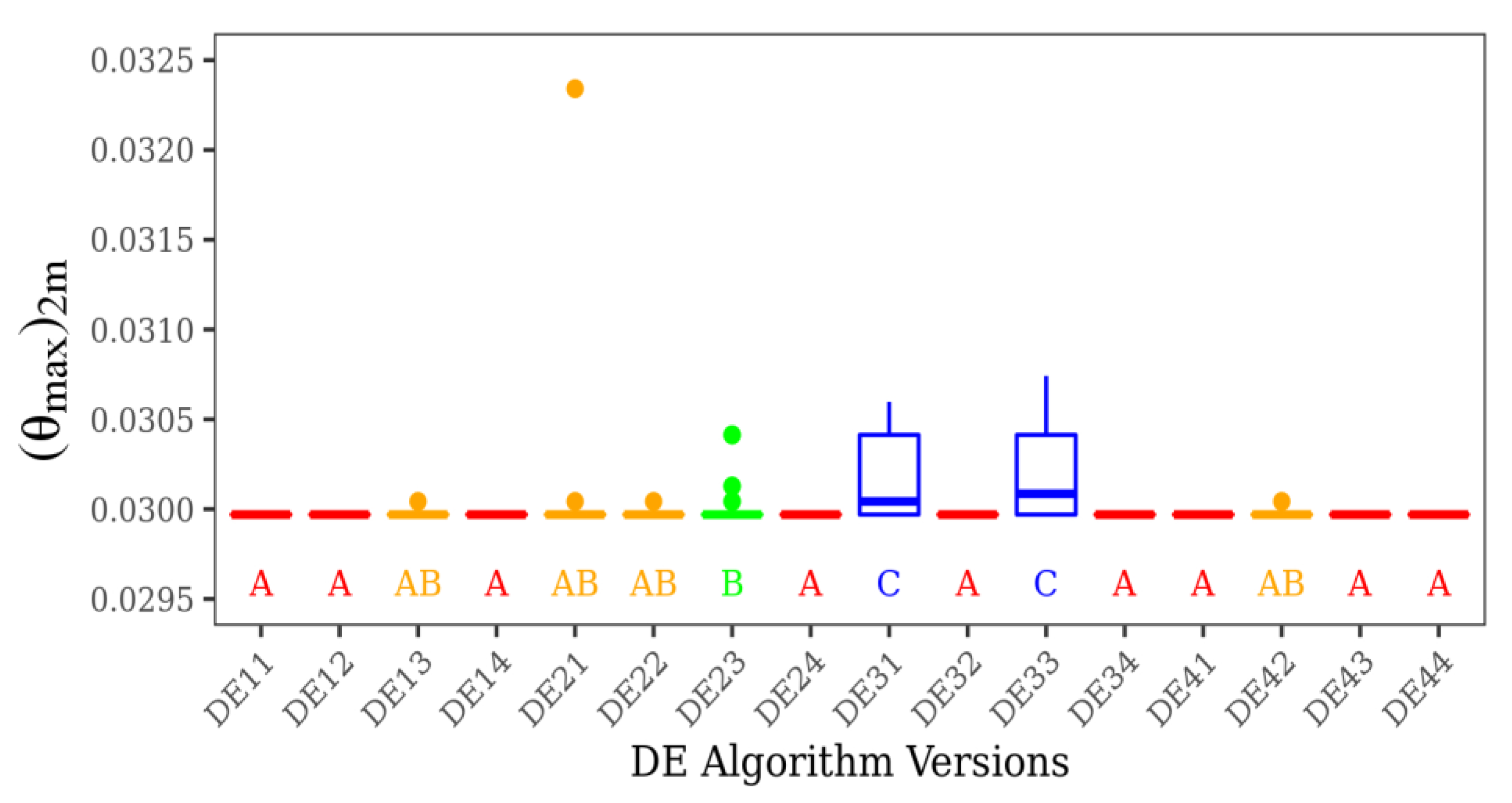
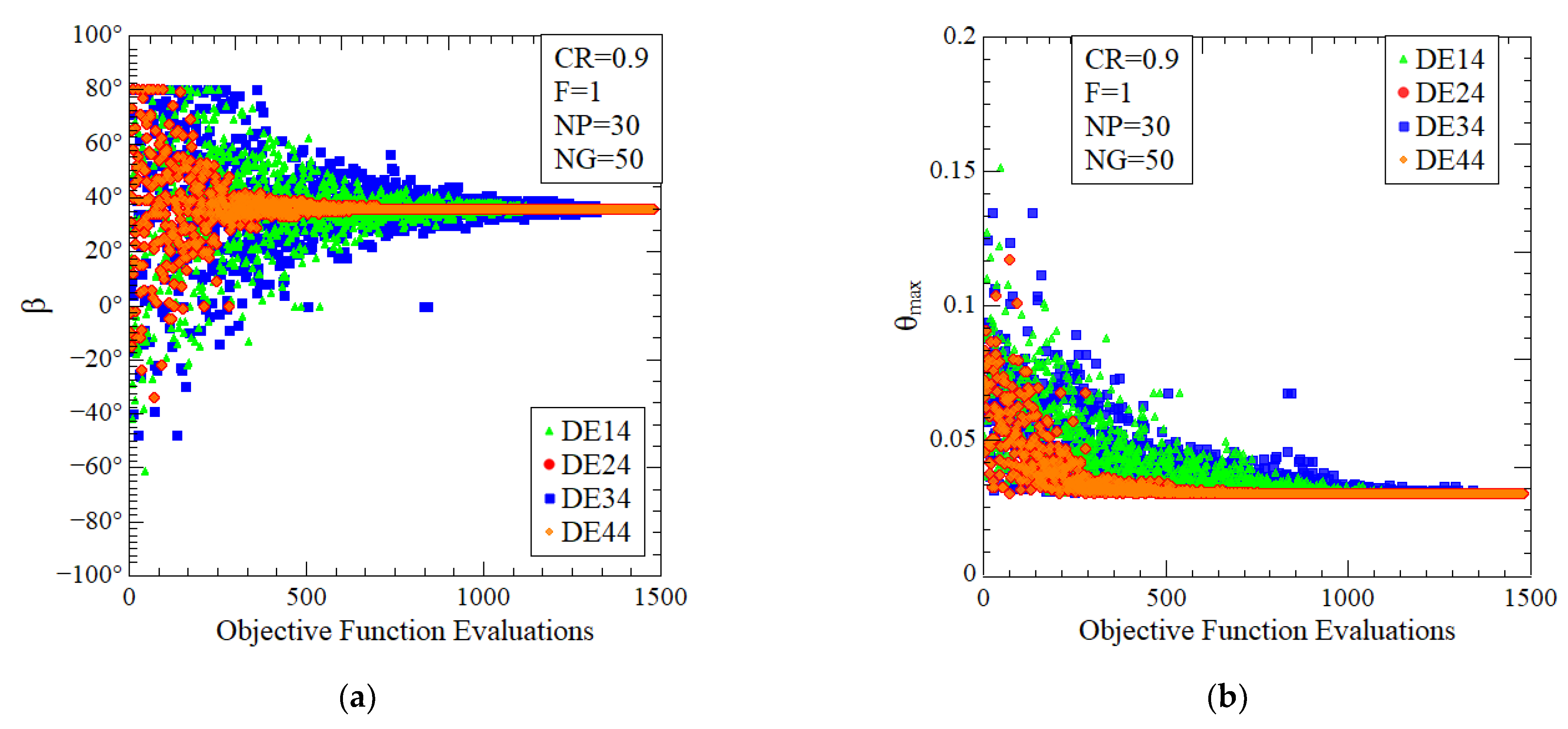
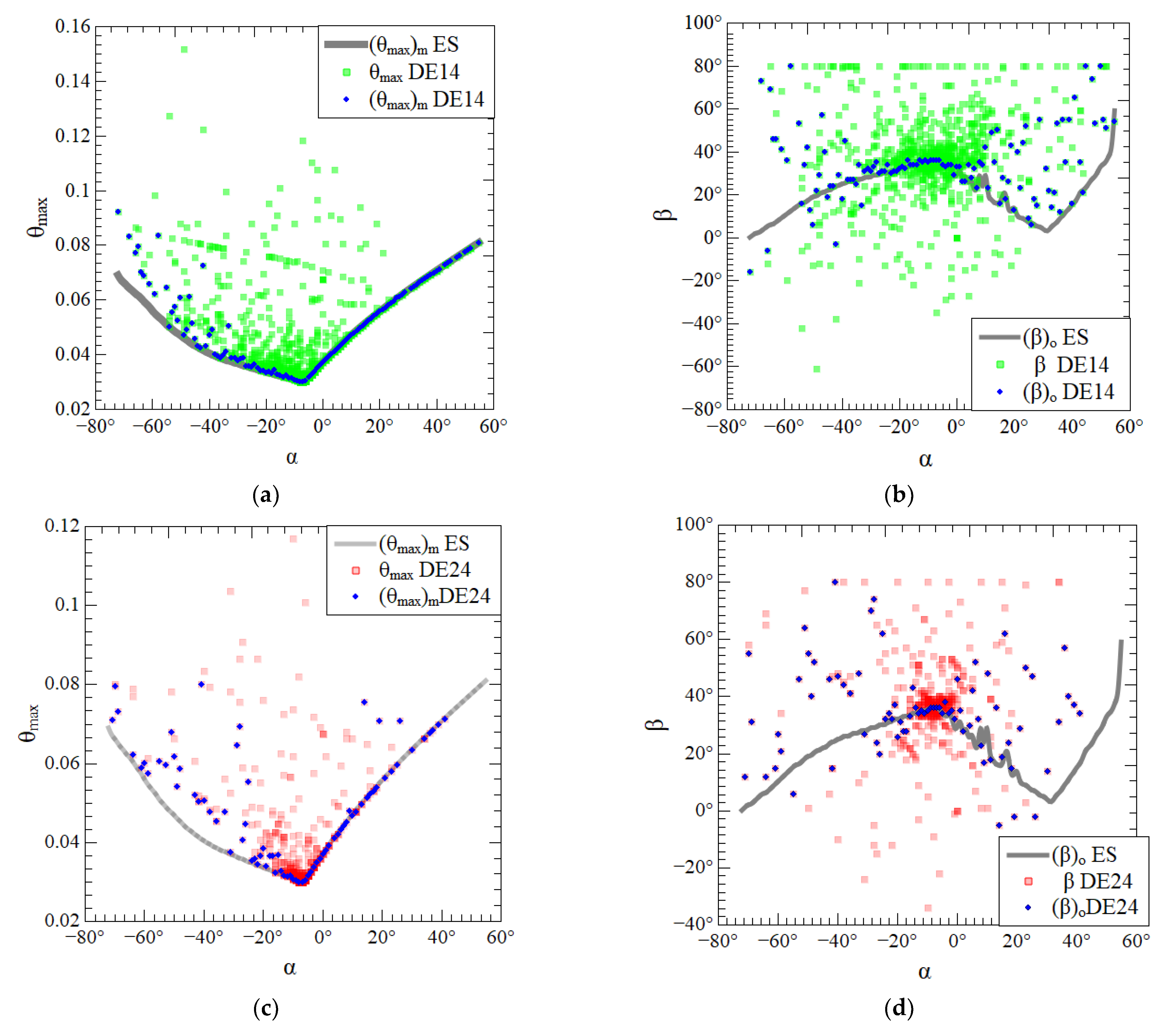
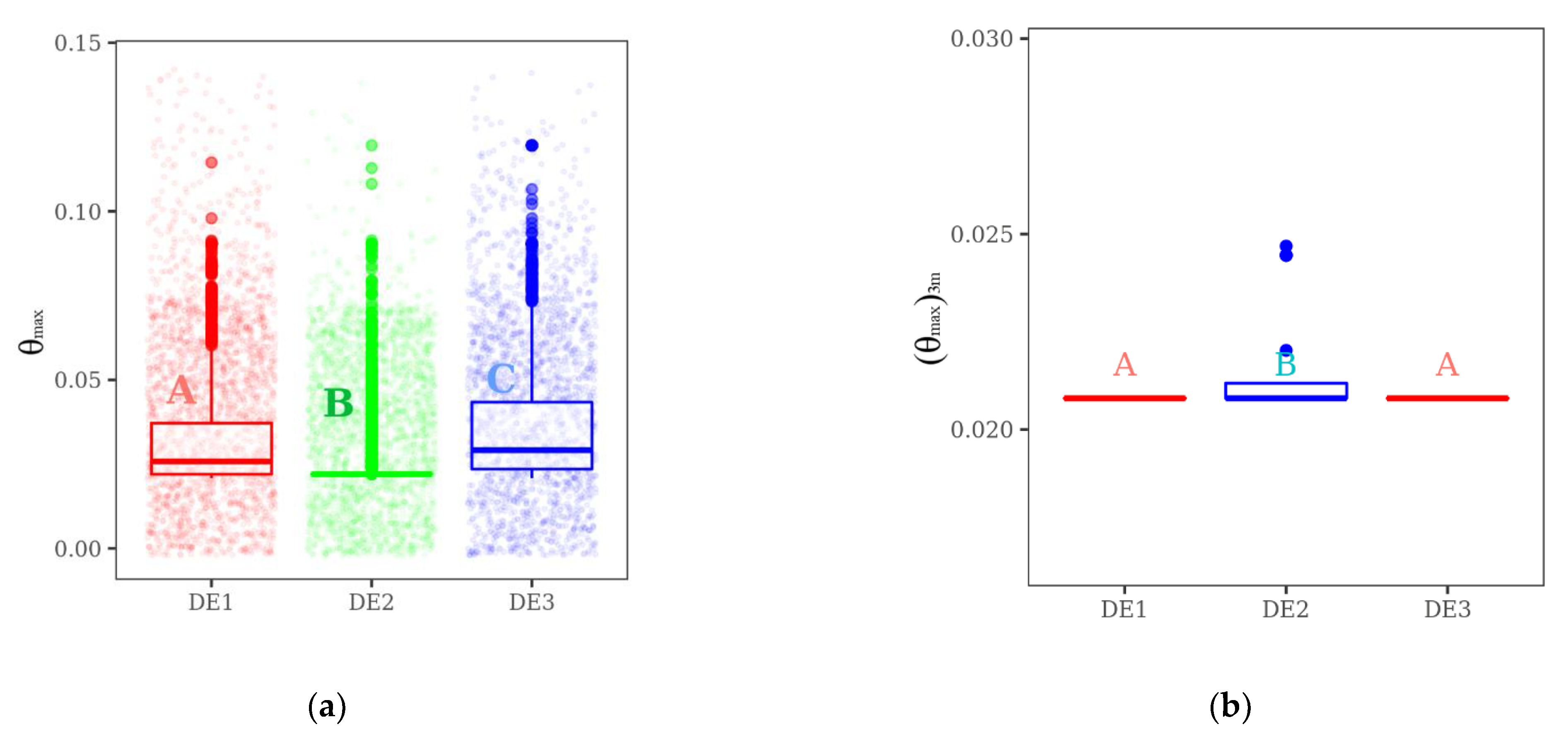
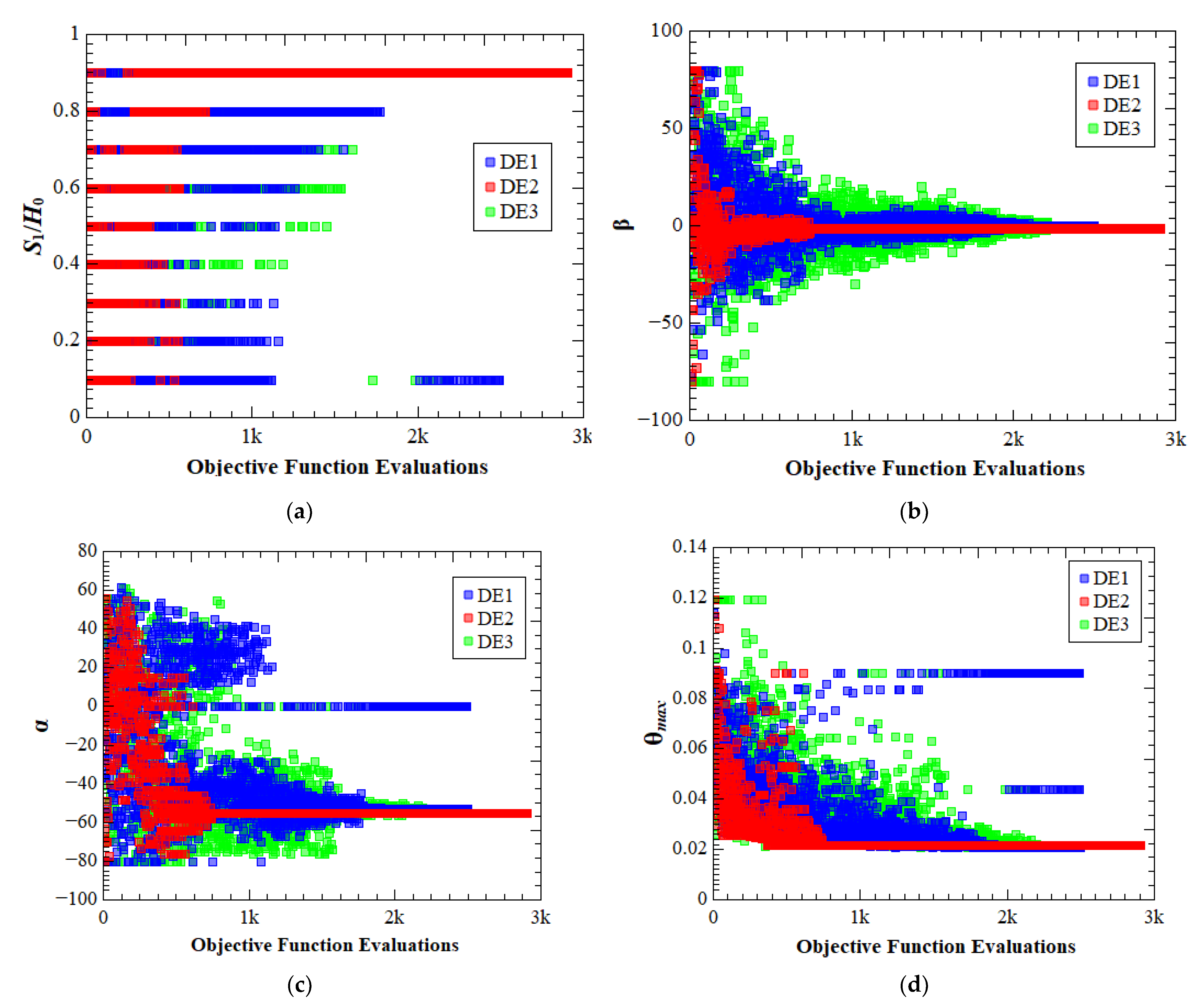

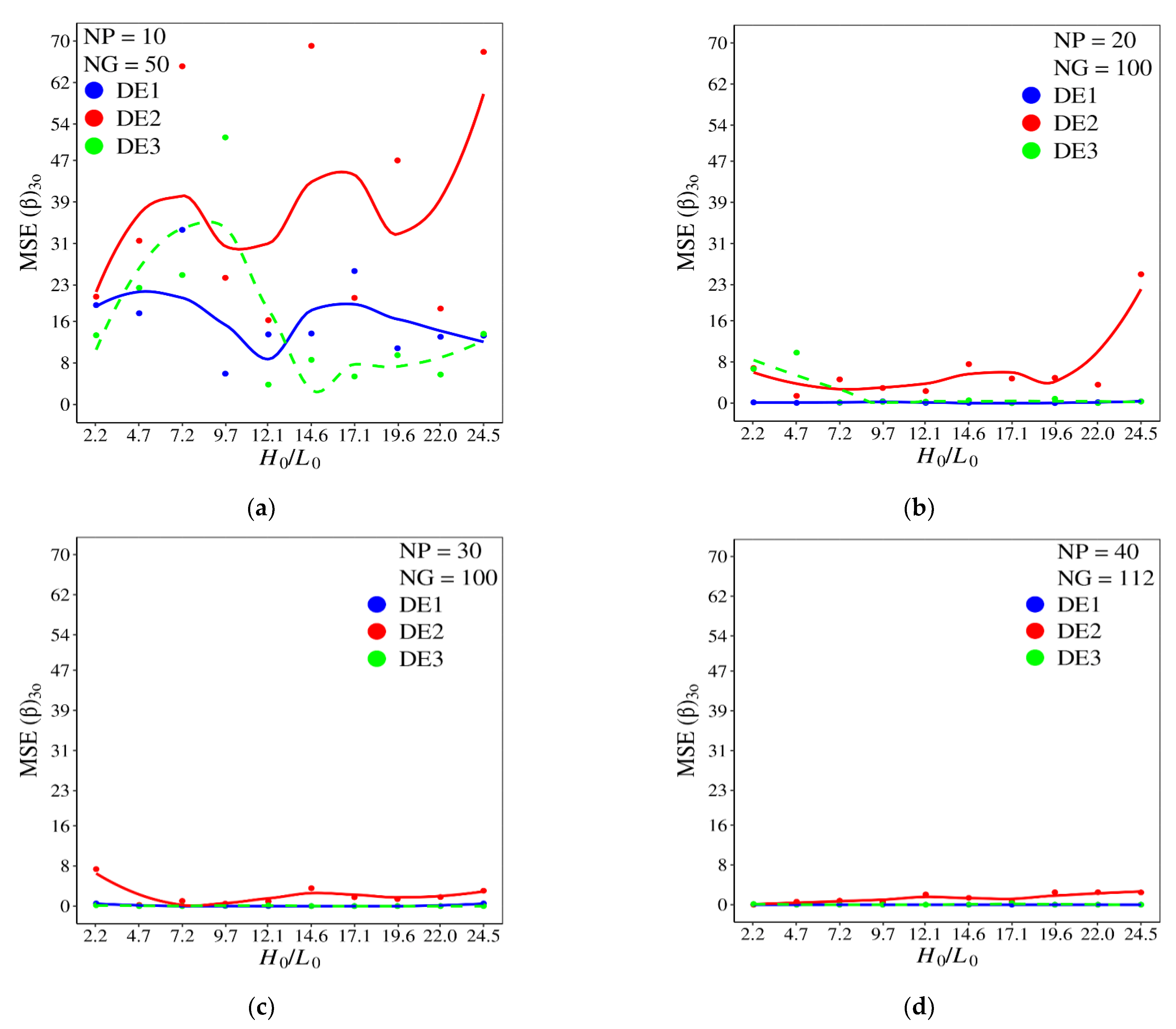
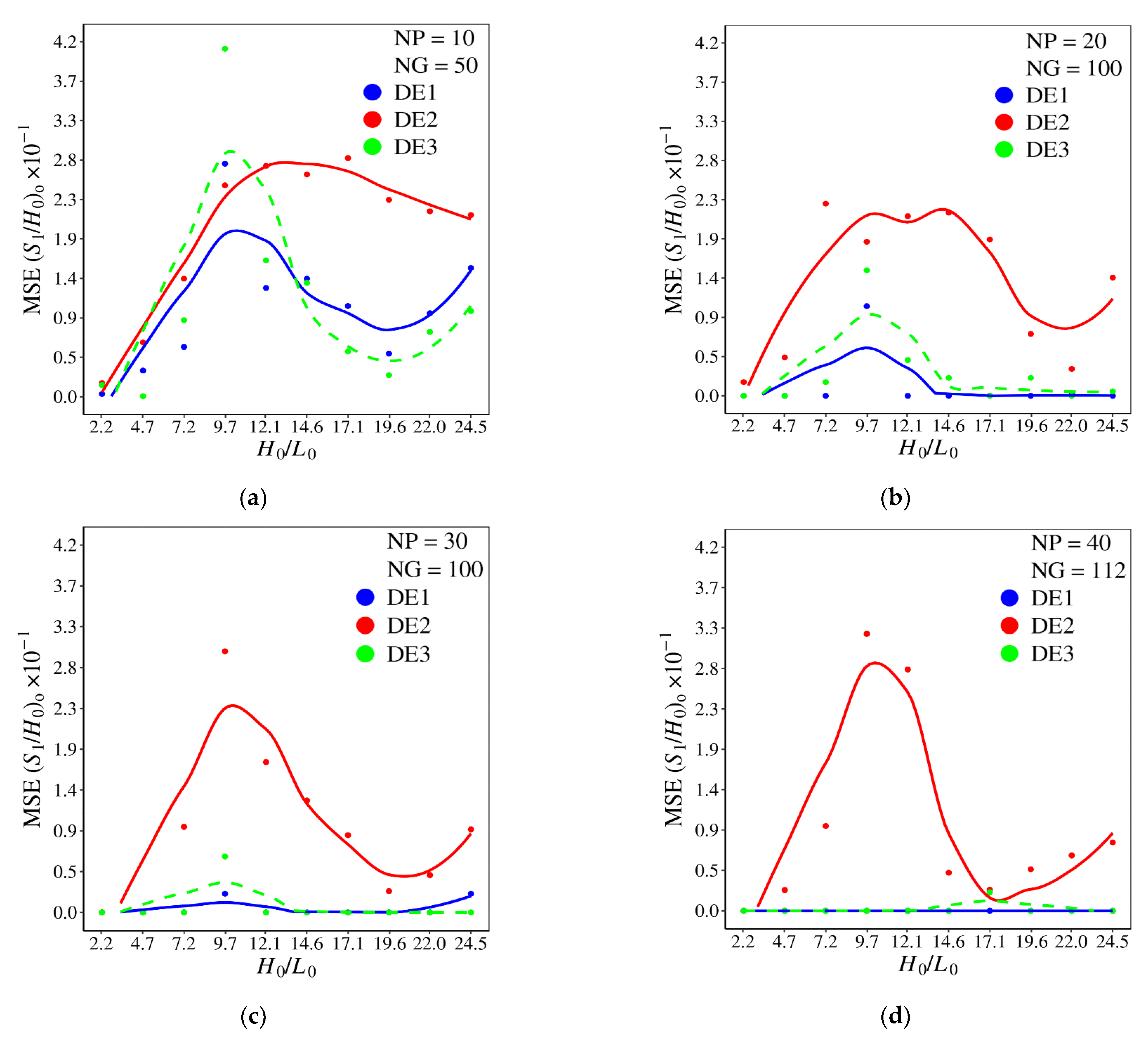
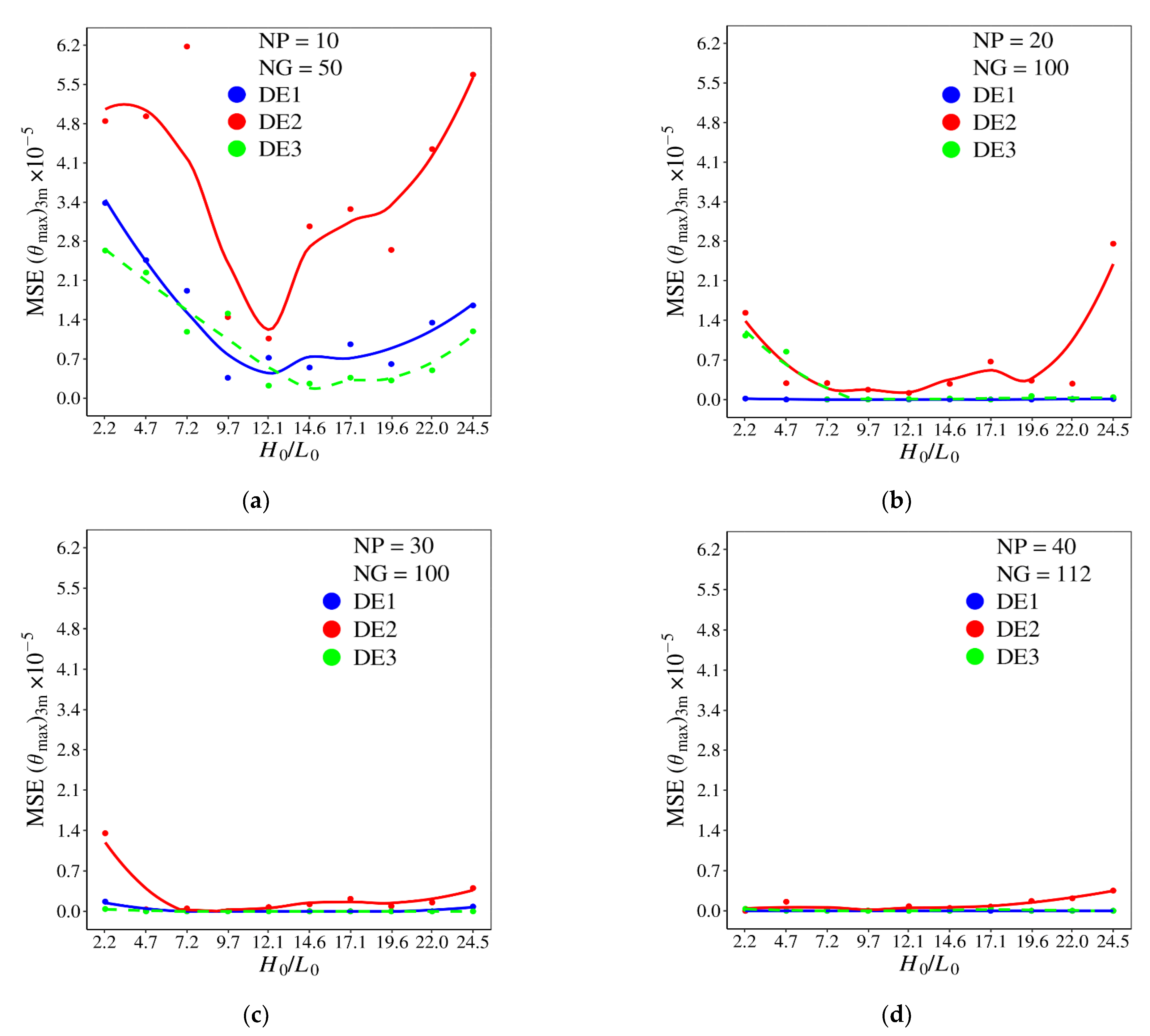
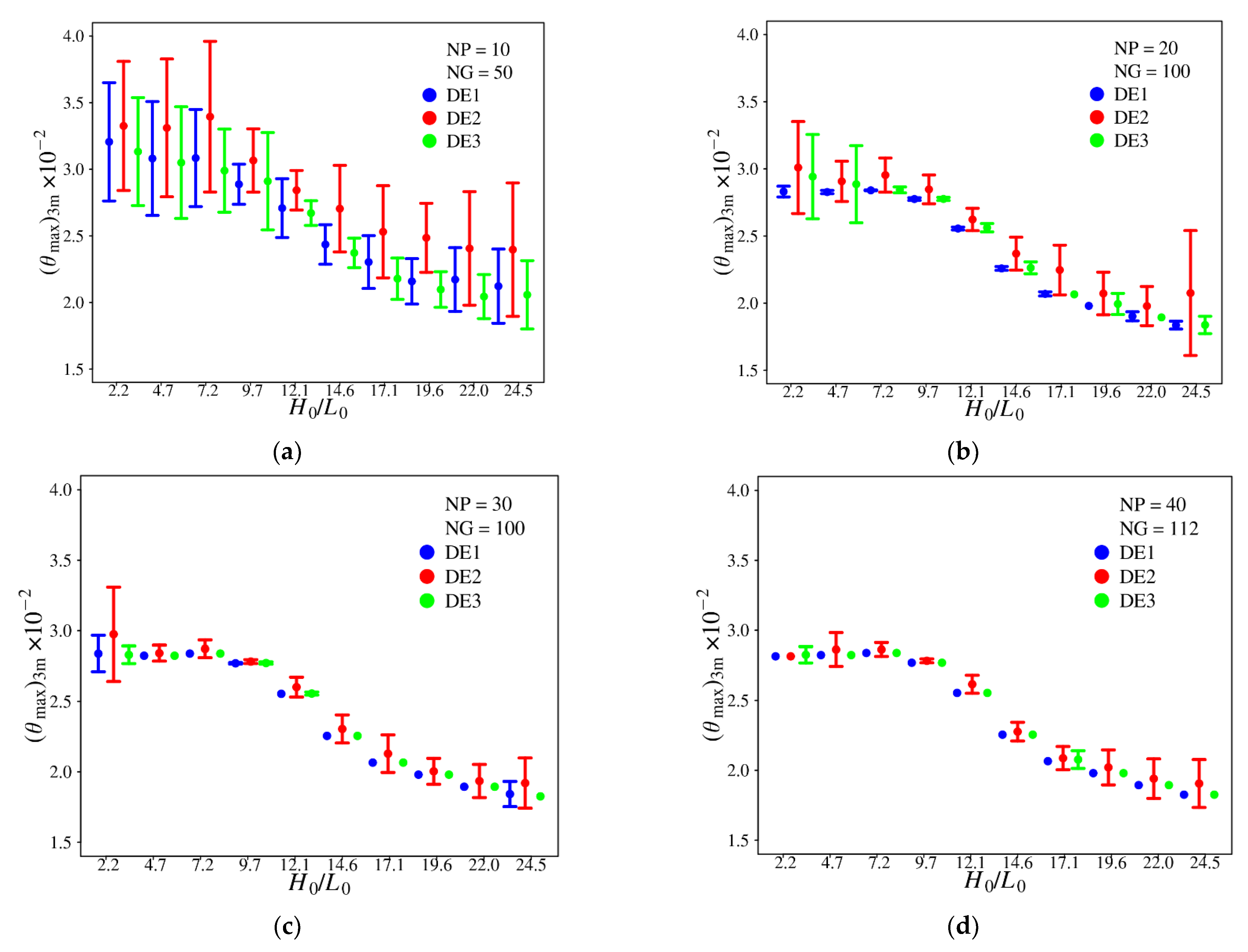

| Number of Elements | θmax | |(θimax − θi+1max)|/θimax |
|---|---|---|
| 1.265 | 0.16767 | 1.2 × 10−3 |
| 5.132 | 0.16787 | 4.579 × 10−4 |
| 20.486 | 0.16795 | 1.866 × 10−4 |
| 82.592 | 0.16798 | 7.307 × 10−5 |
| 325.431 | 0.16799 | - |
| Number of Elements | θmax |
|---|---|
| Present Work | 0.0756 |
| Gonzales et al. [6] | 0.0756 |
| Lorenzini et al. [10] | 0.0762 |
| Biserni et al. [7] | 0.0755 |
| DExy Encoded Name | Crossover | Amplification Factor |
|---|---|---|
| DEx1 | 0.7 | 1.5 |
| DEx2 | 0.7 | 1 |
| DEx3 | 0.9 | 1.5 |
| DEx4 | 0.9 | 1 |
| Mutation Operator | ||
| DE1y | rand/1/bin | |
| DE2y | best/1/bin | |
| DE3y | best/2/bin | |
| DE4y | current-to-best/1/bin | |
| DE Versions | Average (θmax)m | Variance (×10−4) | Standard Deviation (×10−3) | RMSE (×10−3) |
|---|---|---|---|---|
| DE12; DE14 | 0.05232 | 0.017 | 1.33 | 1.61 |
| DE22; DE24 | 0.05253 | 0.038 | 1.96 | 2.24 |
| DE41; DE43 | 0.05491 | 0.728 | 8.53 | 9.10 |
| DE31; DE33 | 0.05770 | 1.870 | 13.70 | 14.9 |
| Shapiro–Wilk: Normality Test | |||
| DE Versions | p-Value | Distribution | |
| DE12; DE14 | 2.785 × 10−6 | Non-normal | |
| DE22; DE24 | 3.275 × 10−7 | Non-normal | |
| DE31; DE33 | 1.489 × 10−9 | Non-normal | |
| DE41; DE43 | 1.870 × 10−4 | N on-normal | |
| Kruskal–Wallis: Rank Sum Test | |||
| DE Versions | p-Value | αs | Differences |
| DE [12; 14; 22; 24; 31; 33; 41; 43] | 1.932 × 10−6 | 0.05 | Significant |
| All versions | 1.109 × 10−7 | 0.05 | Significant |
| DE Versions | Average (θmax)2m | Variance (× 10−7) | Standard Deviation (×10−5) | RMSE (×10−3) |
|---|---|---|---|---|
| DE12; DE32; DE34 | 0.029969 | - | - | - |
| DE13; DE14 | 0.029974 | 0.00344 | 1.86 | 1.89 |
| DE24; DE44 | 0.030169 | 1.94 | 44.1 | 47.7 |
| DE33 | 0.030410 | 1.66 | 40.7 | 59.6 |
| DE21 | 0.030322 | 6.53 | 80.8 | 86.9 |
| DE23 | 0.030472 | 11.2 | 106.0 | 115.3 |
| DE Versions | Average (θmax)2m | Variance (× 10−8) | Standard Deviation (×10−4) | RMSE (×10−4) |
|---|---|---|---|---|
| DE11; DE12; DE14; DE24; DE32; DE34; DE41; DE43; DE44 | 0.029969 | - | - | - |
| DE13; DE22; DE42 | 0.029972 | 0.0178 | 0.134 | 0.134 |
| DE23 | 0.030014 | 1.36 | 1.17 | 1.23 |
| DE33 | 0.030236 | 7.57 | 2.75 | 3.80 |
| DE21 | 0.030051 | 18.7 | 4.33 | 4.33 |
| Shapiro–Wilk: Normality Test | |||
| DE Versions | p-Value | Distribution | |
| DE12; DE32; DE34 | - | Same results for all runs | |
| DE13; DE14 | 4.402 × 10−11 | Non-normal | |
| DE24; ED44 | 7.169 × 10−9 | Non-normal | |
| ED23 | 1.479 × 10−8 | Non-normal | |
| Kruskal–Wallis: Rank Sum Test | |||
| DE Versions | p-Value | αs | Differences |
| DE12–14; DE23, DE24; DE34, DE44 | 1.576 × 10−8 | 0.05 | Significant |
| All versions | 2.2 × 10−16 | 0.05 | Significant |
| Shapiro–Wilk: Normality Test | |||
| DE Versions | p-Value | Distribution | |
| DE11, DE12, DE14, DE24, DE32, DE34, DE41, DE43, DE44 | - | same results for all runs | |
| DE13, DE22, DE42 | 7.76 × 10−12 | Non-normal | |
| DE33 | 9.32 × 10−5 | Non-normal | |
| ED23 | 8.97 × 10−12 | Non-normal | |
| Kruskal–Wallis: Rank Sum Test | |||
| DE Versions | p-Value | αs | Differences |
| All versions | 2.2 × 10−16 | 0.05 | Significant |
| DE Versions | Average (θmax)3m | Variance | Standard Deviation | Standard Error | RMSE (×10−3) |
|---|---|---|---|---|---|
| DE1; DE3 | 0.020797 | 0 | 0 | 0 | 0 |
| DE2 | 0.021520 | 1.91 × 10−6 | 1.38 × 10−3 | 2.52 × 10−4 | 1.54 × 10−3 |
| Shapiro–Wilk: Normality Test | |||
| DE Versions | p-Value | Distribution | |
| DE1; DE3 | - | Same values | |
| DE2 | 2.018 × 10−8 | Non-normal | |
| Kruskal–Wallis: Rank Sum Test | |||
| DE Versions | p-Value | αs | Differences |
| DE1. DE2. DE3 | 4.42 × 10−6 | 0.05 | Significant |
| DE1 | DE2 | DE3 | |||||
|---|---|---|---|---|---|---|---|
| H0/L0 | NP × NG | Average (θmax)3m (×10−3) | Standard Deviation (×10−4) | Average (θmax)3m (×10−3) | Standard Deviation (×10−4) | Average (θmax)3m (×10−3) | Standard Deviation (×10−4) |
| 2.25 | 10 × 50 | 32.05 | 44.37 | 33.25 | 48.44 | 31.32 | 40.51 |
| 20 × 100 | 28.30 | 3.99 | 30.09 | 34.23 | 29.42 | 31.38 | |
| 30 × 66 | 28.39 | 12.86 | 29.75 | 33.39 | 28.30 | 6.20 | |
| 30 × 100 | |||||||
| 40 × 75 | 28.16 | 0 | 28.16 | 0 | 28.26 | 5.81 | |
| 40 × 112 | |||||||
| 12.14 | 10 × 50 | 27.08 | 22.07 | 28.42 | 14.84 | 26.71 | 9.24 |
| 20 × 100 | 25.55 | 1.09 | 26.23 | 8.34 | 25.62 | 4.43 | |
| 30 × 66 | 25.54 | 0 | 26.01 | 7.04 | 25.72 | 3.79 | |
| 30 × 100 | 25.55 | 1.07 | |||||
| 40 × 75 | 26.16 | 6.44 | 25.57 | 1.23 | |||
| 40 × 112 | 25.54 | 0 | |||||
| 24.50 | 10 × 50 | 21.22 | 27.83 | 23.96 | 50.06 | 20.57 | 25.65 |
| 20 × 100 | 18.36 | 2.93 | 20.75 | 46.49 | 18.37 | 6.45 | |
| 30 × 66 | 18.45 | 9.00 | 19.20 | 17.84 | 18.51 | 5.44 | |
| 30 × 100 | 18.42 | 8.93 | 18.26 | 0 | |||
| 40 × 75 | 18.26 | 0 | 19.05 | 17.11 | 18.30 | 1.53 | |
| 40 × 112 | 18.26 | 0 | |||||
Disclaimer/Publisher’s Note: The statements, opinions and data contained in all publications are solely those of the individual author(s) and contributor(s) and not of MDPI and/or the editor(s). MDPI and/or the editor(s) disclaim responsibility for any injury to people or property resulting from any ideas, methods, instructions or products referred to in the content. |
© 2023 by the authors. Licensee MDPI, Basel, Switzerland. This article is an open access article distributed under the terms and conditions of the Creative Commons Attribution (CC BY) license (https://creativecommons.org/licenses/by/4.0/).
Share and Cite
Gonzales, G.V.; Biserni, C.; da Silva Diaz Estrada, E.; Platt, G.M.; Isoldi, L.A.; Rocha, L.A.O.; da Silva Neto, A.J.; dos Santos, E.D. Investigation on the Association of Differential Evolution and Constructal Design for Geometric Optimization of Double Y-Shaped Cooling Cavities Inserted into Walls with Heat Generation. Appl. Sci. 2023, 13, 1998. https://doi.org/10.3390/app13031998
Gonzales GV, Biserni C, da Silva Diaz Estrada E, Platt GM, Isoldi LA, Rocha LAO, da Silva Neto AJ, dos Santos ED. Investigation on the Association of Differential Evolution and Constructal Design for Geometric Optimization of Double Y-Shaped Cooling Cavities Inserted into Walls with Heat Generation. Applied Sciences. 2023; 13(3):1998. https://doi.org/10.3390/app13031998
Chicago/Turabian StyleGonzales, Gill Velleda, Cesare Biserni, Emanuel da Silva Diaz Estrada, Gustavo Mendes Platt, Liércio André Isoldi, Luiz Alberto Oliveira Rocha, Antônio José da Silva Neto, and Elizaldo Domingues dos Santos. 2023. "Investigation on the Association of Differential Evolution and Constructal Design for Geometric Optimization of Double Y-Shaped Cooling Cavities Inserted into Walls with Heat Generation" Applied Sciences 13, no. 3: 1998. https://doi.org/10.3390/app13031998
APA StyleGonzales, G. V., Biserni, C., da Silva Diaz Estrada, E., Platt, G. M., Isoldi, L. A., Rocha, L. A. O., da Silva Neto, A. J., & dos Santos, E. D. (2023). Investigation on the Association of Differential Evolution and Constructal Design for Geometric Optimization of Double Y-Shaped Cooling Cavities Inserted into Walls with Heat Generation. Applied Sciences, 13(3), 1998. https://doi.org/10.3390/app13031998











